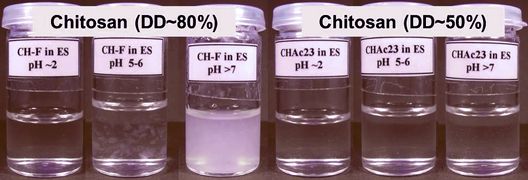In our department, we are particularly concerned with the functionalization of the polysaccharides: dextran, levan, chitosan and alginic acid.
Dextran is a neutral, water-soluble polysaccharide, which is produced extracellularly from sucrose, by bacteria of the genus Leuconostoc (L. mesenteroides and L. dextranicum). As biocompatible materials, they have a multitude of potential applications. Dextran derivatives can be used as coating material for magnetic nanoparticles, for coating biosensor surfaces, or as scaffolds for tissue engineering.
Key derivatives in our department are carboxymethyldextran (CMD) and aminodextran (AMD). While CMD can be produced by etherification, with monochloroacetic acid in alcohol/sodium hydroxide mixtures, AMD is obtained by partial periodate cleavage and subsequent reductive amination. By varying the corresponding reaction conditions, carboxymethyldextranes, with different degrees of substitution (DS ~ 0.7 - 1.7) can be synthesized. Due to its carboxyl groups, the CMD is particularly suitable for the immobilization of amino group-containing biomolecules, active ingredients, dyes or linkers.
In contrast, the introduced amino groups of the AMD (approx. 80 - 300 µmol NH2/g, depending on reaction conditions), allow the binding of molecules containing carboxyl groups. By further derivatization reactions, radical cross-linkable groups (e.g. methacrylates), can also be introduced into the dextran.
The interest in chitosan derivatives as potential materials for use in medicine, has recently increased considerably. This is due to their minimal foreign body reaction, their antibacterial, anti-inflammatory and haemostatic effects, and their ability to form porous, three-dimensional structures, which are important for improved cell ingrowth behavior. The limited solubility of chitosan (only soluble in diluted acids), is a challenge for applications in the medical field, as well as for the performance of certain functionalization reactions. By selective acetylation of the free amino groups (adjustment of the DD to approx. 50 %), it is possible to obtain chitosan, which is soluble at neutral pH. Water-soluble chitosan derivatives can be produced by carboxymethylation, sulfation and phosphorylation reactions.
Alginic acid is formed by brown algae and some bacteria (e.g. Azotobacter). The salts of alginic acid (alginates), are mainly used as thickening or gelling agents. We deal with the introduction of sulfate, or carboxymethyl groups, into the polymer backbone, to obtain biologically active substances or carrier materials. The sulfation is mainly performed using the SO3/pyridine complex in DMF as a solvent. Sulfated alginates with a sulfation degree of approx. 1.5 - 2.5 are obtained, depending on the reaction conditions. The molar masses of the alginates used, change only slightly during this reaction. The carboxymethylation of alginates, is carried out analogously to that of dextran. The degree of substitution is found to be between 0.2 - 0.9. By intercalation of divalent cations (e.g. calcium and barium ions), into the structure of the GG blocks, hydrogels can be produced from alginates.
We would be pleased to take over your custom synthesis. Detailed information about the synthesizable compounds can be found here.






